Present truth under a historical roof
Beaconsfield SDA church gets a new lease on life
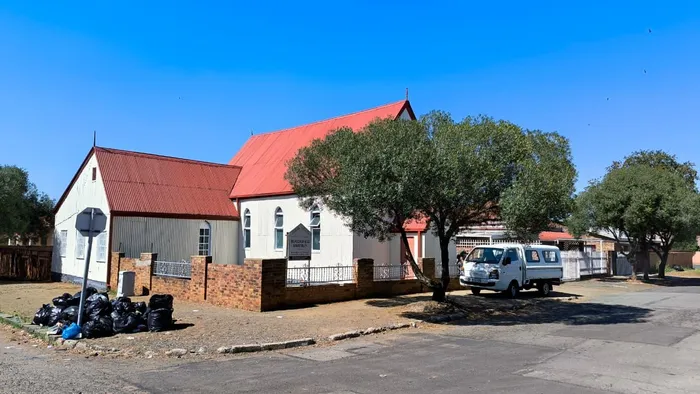
Recently, a team from the Ellen G White Estate based in Silver Spring, Maryland, USA, started renovations on the Beaconsfield Seventh-day Adventist Church in Blacking Street.
Image: Lance Fredericks / DFA Newspaper
MONUMENTS are fantastic! They’re great to visit, fascinating to learn from, and humbling to consider what it took to erect and preserve them.
Also, it’s heartbreaking to witness monuments falling into disrepair – and here I include monuments erected to heroes as well as those considered villains.
The point is, monuments, statues, and memorials are important “Ebenezers” that point us back to our roots, enabling us to decide who to emulate, and whose influence to reject.
For those wondering about the term “Ebenezer”, the concept originates in the Bible, in 1 Samuel 7:12, where the prophet Samuel sets up a stone between Mizpah and Shen and names it “Ebenezer”, meaning “the stone of help”.
The verse occurs after the Israelites, guided by Samuel, defeated their enemies in a battle. The phrase associated with it is, “Thus far the LORD has helped us!”.
New life for a historical site in the city
Recently, a team from the Ellen G White Estate based in Silver Spring, Maryland, USA, started renovations on the Beaconsfield Seventh-day Adventist Church in Blacking Street.
The church, built in 1890 – just five years after the Cape Town Railway reached Kimberley – with stone foundations, zinc walls and roof, wooden floors, and hearts filled with a passion to spread the message of God’s soon return, has stood for over a century, initially doing just that.
However, for decades the building on the corner of Dyer Place and Blacking streets has been a silent reminder of the zeal of days gone by. Not that the worshippers over the years had lost their passion, but standing in Kimberley’s scorching summers and freezing winters for 135 years can weather any structure.
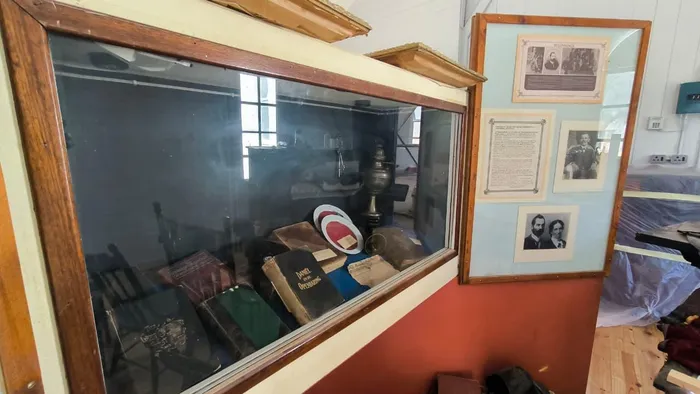
The church, built in 1890 – just five years after the Cape Town Railway reached Kimberley – is overflowing with history.
Image: Lance Fredericks / DFA Newspaper
An Ebenezer in Kimberley
But with the work of restoration already under way, Markus Kutzchbach, one of the Associate Directors of the Ellen G White Estate, speaks about why historic sites are important, and why this grand old church is an Ebenezer. “If you go to the Bible, to Joshua, chapter four, God asked Joshua to take 12 stones out of the Jordan river, to pile them up,” says Kutzchbach.
“Why? God said, ‘When the future generations would come up, and they do not know what happened today (when the nation crossed over the river miraculously), and they will see these stones, and they will ask you what do these stones mean to you, then tell them about what you experienced today; about the mighty acts of God.’
“So what we do here, continues Kutzchbach, “is the same thing.”
Not a mere curiosity
What makes this restoration different, though, is that the Beaconsfield SDA church is not going to be a monument in the ordinary sense of the word. According to Tinus Prinsloo, who has been hands-on with the restoration work, the plan is to resume church services starting this Saturday, October 4, at 9.30am.
“In the pre-programme in the morning, I am going to elaborate more on the history of the church, and about Adventism, starting from 1844 all the way till William Hunt, how he came here,” Prinsloo told the DFA.
William Hunt was the first known American Seventh-day Adventist to come to South Africa. With no theological training, Hunt still shared his personal faith in his missionary work, and he helped establish the Beaconsfield church.
So, for those who have an interest in spiritual matters, as well as a passion for the history and heritage of the Diamond City, the Beaconsfield SDA church is the place to be on Saturday morning.
You'd want to get there early.
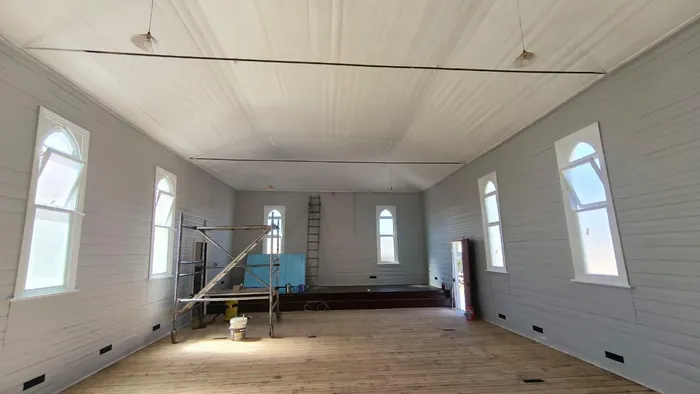
The floors have been sanded, and over a century of wear and scuffmarks were removed for Saturday's service.
Image: Lance Fredericks / DFA Newspaper
A city of firsts – light, cash, and enlightenment
Kimberley is known for historical firsts. To name but two, it’s well known that on September 2 1882, Kimberley became the first city in the Southern Hemisphere and the second in the world after Philadelphia, in the United States, to install electric street lighting.
In addition to this, the first stock exchange in Africa was built in Kimberley as early as 1881.
Now, before we proceed, it’s important to note that the humble zinc structure in Beaconsfield is the launching pad for the Seventh-day Adventist church in South Africa, but beyond that, it is the first Adventist church that was built on the entire continent of Africa.
Today, there are believed to be just short of 1,500 churches and almost 100,000 members in South Africa alone, but the statistics balloon as you head deeper into Africa.
For the record, maybe we should mention that the oldest church in Kimberley is St Martin’s located at the Open Mine Museum. This Lutheran Church building was inaugurated in 1875. Its building materials were imported from Europe and the church stood in Thompson Street.
However, according to the most reliable sources, the second oldest surviving original building is most likely the Kimberley Seventh-day Adventist Church at the corner of Blacking and Dyer Place.
And, with the church set to resume weekly Sabbath services, there are also plans to establish a visitor’s centre and further develop the church’s grounds.
Those busy with the restorations are of the opinion that, being such an important landmark, it would be good to make it a more welcoming place.
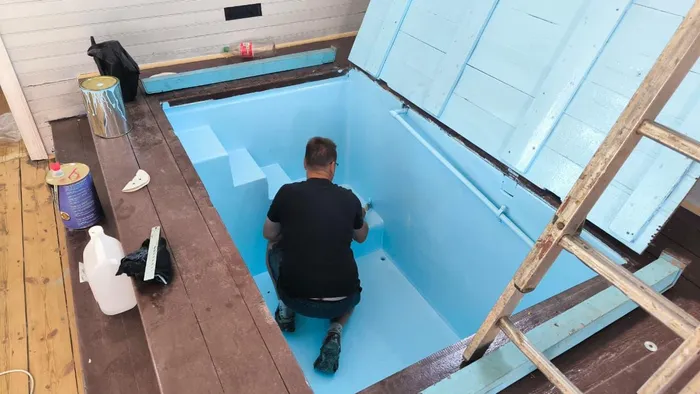
Tinus Prinsloo is seen adding a coat of paint to the church's font; a place from where the message of God's love launched into South Africa and beyond.
Image: Lance Fredericks / DFA Newspaper
The deeper value of our monuments
Though the restoration is far from done, the work accomplished thus far is impressive. The building’s exterior and roof have a fresh coat of paint (that’s a euphemism).
Dolf Smit, a rooftop contractor who was hands-on with the restoration, says that the roof of the building was meticulously refurbished. He tells the DFA that he was amazed at the condition of the original zinc plates, that they were in almost pristine condition.
“For zincs to last over 100 years and look like that, is nothing short of a miracle,” Smit says.
Back on the ground, the driveway has been refurbished, and other important aesthetic touches have been added.
Inside, the wooden floors have been sanded down, revealing the beauty of the original timber; the pews were also being touched up on Friday.
One gets the impression that popping in on Saturday will give visitors the feeling of what the pioneers experienced on that first day when the church opened over 100 years ago.
A part of Kimberley’s heritage
The renovations and restoration are important for the city as it is a movement in the direction of protecting Kimberley’s cultural and spiritual heritage, and not just the church’s heritage.
Ultimately, the value of projects like this is a powerful boost for future generations. At the living, active, thriving monument in Beaconsfield, the Adventist as well as Kimberley’s youth will get to see, touch, and connect with the city’s rich, layered history, giving them tangible evidence that well-established foundations can produce abundant fruit.
As one of the founders of the Seventh-day Adventist Church, Ellen White, writes: “We have nothing to fear for the future, except as we shall forget the way the Lord has led us, and his teaching in our past history.”
To be sure … No matter who you are, you can surely take those words of wisdom to heart.
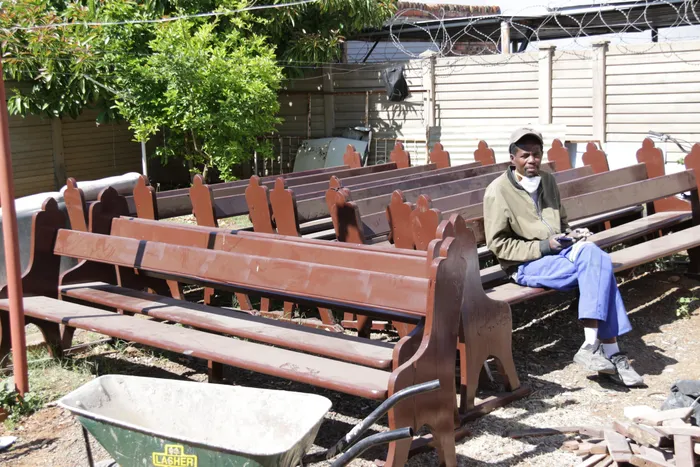
Late Friday afternoon there was still quite a bit of work to be done, as the pews still needed a touch up.
Image: Lance Fredericks / DFA Newspaper